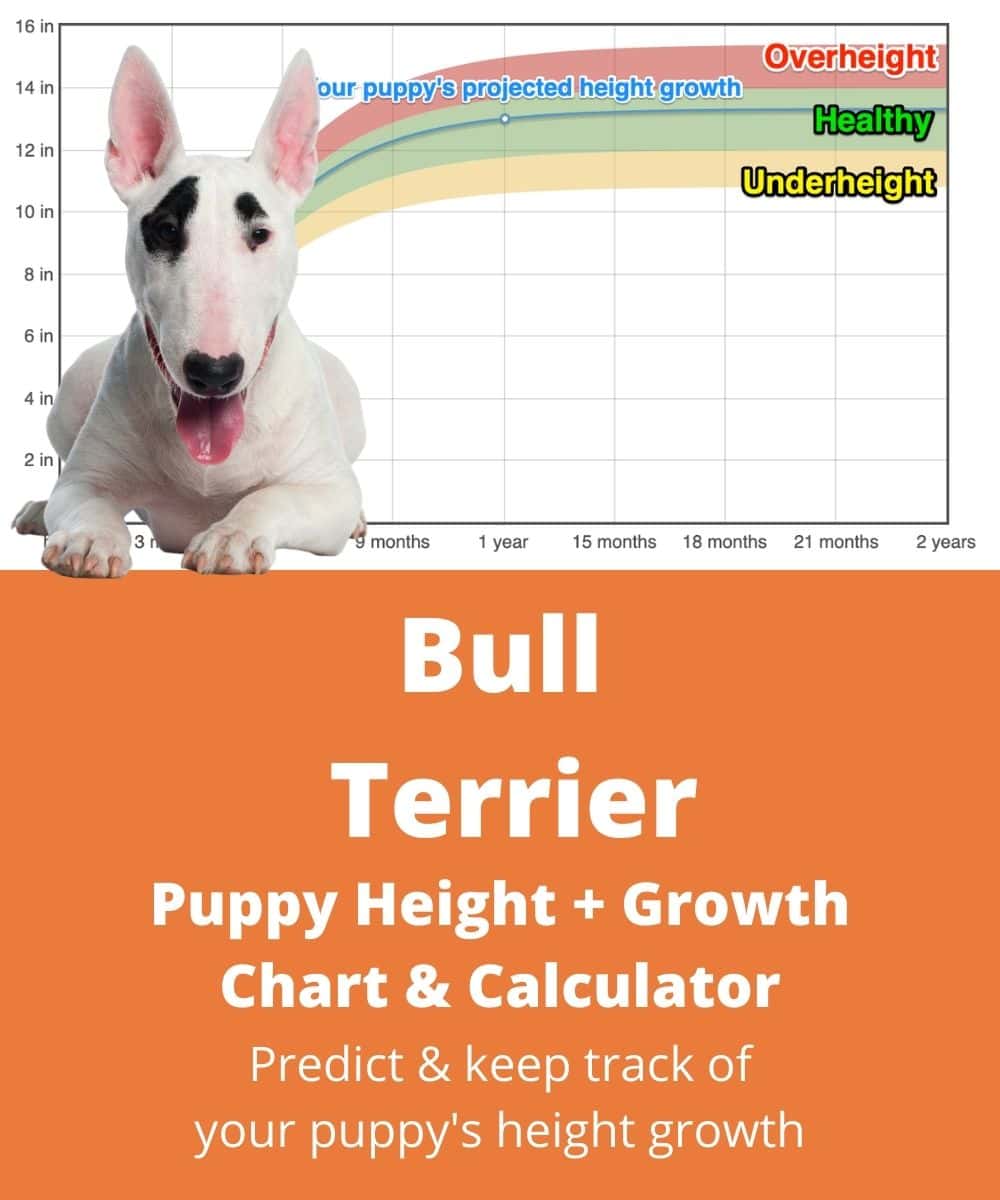
How tall will your Bull Terrier puppy grow into?
Estimate the adult height of your Bull Terrier puppy in 5 simple steps using our free puppy height chart!
Protect your beloved pets without breaking the bank
- Unlimited video calls & texts with vets
- Available 24/7
- Annual $3,000 emergency fund
- LIMITED TIME - 7 DAYS FREE trial
- SPECIAL OFFER - 20% OFF 1st month
Code: GOODY20
- Flexible coverage
- Hassle free claims
- Multiple pets family plan
Quiz Time!

Dogs come in all sizes, shapes, and heights, from tiny teacup pooches to the gentle giants that we simply cannot get enough of. The height your dog grows to be is particularly important not only due to personal preference but also as it is part of your dog's identity and potential life quality.
How tall your puppy will grow up to is dependent on a number of factors, but the most important are breed and individual genetics.
In the sections below, we shall answer all the questions you probably have about figuring out your dog's potential height, from what determines it to how to predict it.
That way, you will have a great idea of what to expect from your pooch before or once you bring them home with you. After all, is said and done, size really does matter when it comes to your dog's height, both for you and your dog.
How Tall Will Your Puppy Grow Into?
How tall your dog will grow to become depends on several factors. In the sections below, we shall go deeper into the most important of these factors to help you better understand your dog and its height potential.
Breed
Each dog breed has its expected height range. This is based on genetics that is passed down from the puppy to its parents.
Therefore, if you wish to know what your dog's height potential is, it might help to take a look at its dog breed's weight and height ranges.
However, you will notice that the ranges are often quite wide as many other factors are at play when determining your dog's potential height.
Gender
Most dog breeds display what is referred to as sexual dimorphism. This phenomenon refers to differences in physical characteristics between male and female members of the same species.
In this case, the dimorphism results in male dogs typically being taller than their female counterparts. As a result, you will notice that the average height ranges given for your dog's specific breed are divided into two sets of ranges, one for males and one for females.
Diet
Your dog's height is determined mainly by its bones, but the muscles could add a few significant inches to the final height value. The dog's diet largely determines both bone and muscle growth.
As such, dogs that have a healthy diet are more likely to reach their full height potential than those that are malnourished in one way or another.
Health Status
Studies have shown that sickly dogs are less likely to achieve their full height and size potential than dogs with no recurring health issues.
These issues mainly refer to health problems that affect the dogs in their crucial puppyhood, where most of the growth happens. The conditions could be anything from chronic or recurrent infections to lifetime conditions like epilepsy.
Individual Genetics
It is possible for dogs to be significantly shorter than what is expected for their breed, even with a good diet and overall health. In these cases, individual genetic mutations are to blame for the failure to thrive.
The most common of these genes are disproportionate dwarfism genes, including those that cause short legs in dogs like corgis and dachshunds.
There are also rare genetic mutations such as the gene responsible for Pituitary Dwarfism in traditionally tall dog breeds like German Shepherds, Carnelian Bear Dogs, and Weimaraners.
How Long Does It Take For A Puppy To Reach Its Full Height?
The age at which your dog will reach its full height depends on how large the dog breed is expected to be. Larger dogs typically take much longer to reach physical maturity than their smaller furry companions.
In a nutshell, small dog breeds typically stop growing at 6 to 8 months of age, while medium dog breeds require about 12 months to reach their full height. Finally, large dogs can take up to 18 months to grow to their specific breed's expected height.
How Can I Estimate My Dog's Expected Height?
The best way to predict your dog's height is using a dog growth chart. These may be provided by your vet but can also be found online. More often than not, these charts are based on your dog's general size category, which could either be miniature, small, medium, or large.
However, it is possible to get a puppy growth chart specifically designed to track growth for an individual dog breed.
The best part about puppy growth charts, in general, is that they help you keep track of your pup's growth and to pick up on any growth retardation early enough to intervene appropriately.
In addition to puppy growth charts, you could also use growth calculation formulas to try and estimate your dog's expected height. You can make your life easier by using an online growth calculator. Just make sure that you find one that accounts for a dog breed and gender for more accuracy.
Can You Change How Tall Your Dog Grows To Be?
The answer is both yes and no. For the most part, the majority of the factors that determine your dog's potential height are beyond your control. These include factors like gender, individual genetics, and the dog's breed.
However, there are a few factors within your control that could help you influence your dog's height. Just remember that these will only give you a way to help your dog reach its full potential but will not actually change its expected height range.
Without further ado, here are a few ways to determine how tall your dog will grow to be.
Ensure They Have An Adequate Diet
A diet rich in protein is crucial for your dog's growth, especially when it comes to muscle development. Because muscles contribute a small but significant amount to your dog's height, having a protein-rich diet could help your puppy get closer to its expected height.
Furthermore, ensure that your dog's diet is rich in nutrients that support bone development and strength. These include minerals like calcium and phosphorus, as well as vitamins like vitamin D.
Prioritize Regular Vet Care
A healthy dog is more likely to reach its predicted height range, which is why you have to make sure that your dog's health is well covered. This includes keeping up with vaccinations and deworming.
It also means seeking veterinary care when your dog gets sick and keeping up with both routine and follow-up vet appointments.
Give Your Dog A Happy And Safe Home
Finally, it is important to ensure that your dog is happy and that its mental wellbeing is a priority. This is because, like its diet and physical health, your dog's psychological health heavily influences its growth.
This may also mean getting professional help for any issues your puppy may be facing, from separation anxiety to PTSD.
Does Paw Size Determine Your Dog's Height?
Your dog's paw size cannot be used as an accurate predictor of how large your dog will be. However, there is an undeniable relationship between this paw size and your dog's eventual height.
This is because taller dogs also tend to be heavier and thus require large, sturdy paws to support all that weight.
Despite this relationship, there is no way to definitively conclude how tall or short your dog will be by simply examining its paw size.



